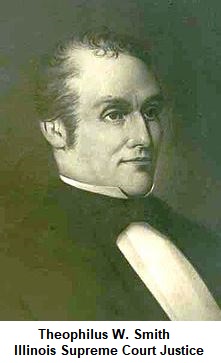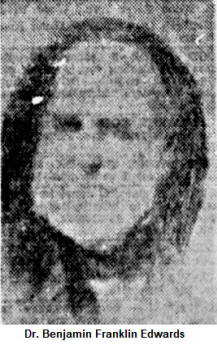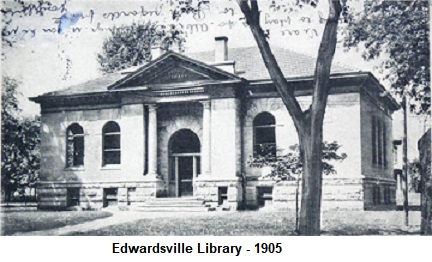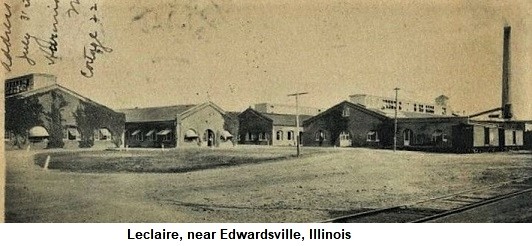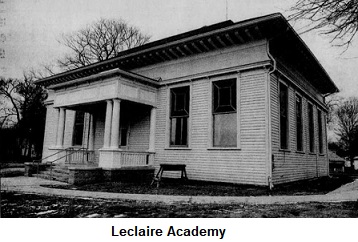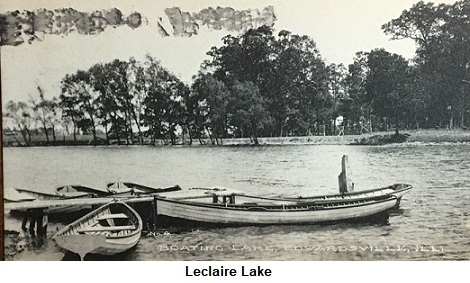Early History of Edwardsville
Edwardsville Newspaper Articles | Leclaire Newspaper Articles
Thomas Newton Kirkpatrick was born
in York County, South Carolina, in 1766. He was the son of James
Franklin (1743-1781) and Susannah Gillham (1746-1831) Kirkpatrick.
James’ father (James Kirkpatrick Sr.) emigrated from Belfast,
Ireland in 1736, and lived in Pennsylvania prior to South Carolina,
where he received land grants for his service in the American
Revolutionary War with the South Carolina militia.
Thomas Kirkpatrick settled in what would become Edwardsville in
1805. He previously lived in Georgia, where he was a Justice of the
Peace. Accompanying Thomas were two of his brothers and a large clan
of the Gillhams, all of whom immigrated from South Carolina. Thomas
built his cabin on a militia claim of one hundred acres on Cahokia
Creek, originally granted to Pierre Lejoy, a Frenchman who had been
enrolled in the U. S Militia in 1790. This claim covered the
northwest part of the present town of Edwardsville. The Land
Commission also recognized "preemption" claims of five Gillhams and
three Kirkpatricks, to eight adjoining bundles of 320 acres each,
mostly situated on Cahokia Creek. Preceding the War of 1812-14, a
block house was constructed for the protection of several families
which had settled in the vicinity. This structure was known as
Thomas Kirkpatrick’s Fort, and was an important link in the chain of
military stations which guarded the Illinois frontier. The block
house stood to the north of the old court house, about 300 yards
from the banks of Cahokia Creek. It is said to have been built by a
military company, of which John G. Lofton was Captain, William Jones
First Lieutenant, and Daniel G. Moore Second Lieutenant. Thomas
Kirkpatrick died December 16, 1821, in Greenville, Bond County,
Illinois, and is buried in the Moody Cemetery in Bond County.
The county of Madison was organized in 1812, and the Kirkpatrick
farm was selected by Governor Ninian Edwards as the best location for the seat of justice. At
the house of Thomas Kirkpatrick, on April 5, 1813, the court of
common pleas for Madison County held its first session. At this term
of court, Kirkpatrick obtained license to keep a public house. The
first merchant in Edwardsville was Abraham Prickett, and the second
was Benjamin Stephenson. Their stores were opened in 1815 or 1816.
John T. Lusk was the proprietor of the first hotel.
In 1816, a town was surveyed and platted by Kirkpatrick and called
Edwardsville in honor of Ninian Edwards, then the Territorial
Governor of Illinois. In a few years Edwardsville attained a
population of several hundred. Governor Edwards made it his
residence, and a bank was established. The town became the seat of
the U. S. Land Office, and enterprising and talented men flocked to
the town to push their schemes for gaining wealth.
The first mention of a government for the town was on February 23,
1819, when an act was passed by the State Legislature appointing
Benjamin Stephenson, Joseph Bowers, Robert Latham, John Todd, Joseph
Conway, Abraham Prickett and Theophilus W. Smith as the Board of
Trustees. On May 3, 1819, an election was held at which Abraham
Prickett, James Watts, John Todd, Robert Pogue, William Holland,
Palemon H. Winchester, and William L. May were chosen Trustees. At
this election, Josias Randle, Abraham Prickett, and Paris Mason
acted as judges, and John Y. Sawyer and Stephen Dewey as clerks.
In 1819, Benjamin Stephenson, Ninian Edwards, Theophilus W. Smith,
John Todd, and others, petitioned the Board of Trustees that a tract
of land owned by them, adjoining the town and which they had laid
off into lots, should be annexed to and made a part of the town of
Edwardsville.
In 1819, Edwardsville was described as a flourishing town with sixty
or seventy houses, a court house, jail, public bank, printing
office, and a U. S. Land Office with Colonel Stephenson as
“receiver.” There was also a society of Methodists.
NATIVE
AMERICANS
Edwardsville, until 1824, was the site of an Indian Agency, where
treaties were signed between Native Americans and representatives of
the United States. On August 6, 1819, at Edwardsville, a treaty was
negotiated between Auguste Chouteau and Benjamin Stephenson,
commissioners of the United States, and the chiefs of the Kickapoo
tribe. The Kickapoos ceded all their land on the northwest side of
the Wabash River, including their principal village and tract of
land covering the central part of the state of Illinois, estimated
to contain upward of ten million acres. The United States agreed, in
return, to pay the Kickapoos two thousand dollars in silver,
annually, for fifteen successive years, and to guarantee them
peaceable possession of their country on the Osage, and to restrain
all whites from hunting or settling therein. The United States also
promised to furnish two boats in which to transport the property of
the Indians from some point on the Illinois River to their new place
of residence, and to select a white citizen to accompany them in
their journey through the white settlements. Proclamation was made
of this treaty on January 13, 1821.
On February 12, 1824, a group of Native Americans gathered on the
Springfield Road near Edwardsville, to witness the hanging of
Eliphalet Green (the first in Madison County), who was tried and
convicted for murder. The Native Americans wanted to see how
"civilized" man killed their fellow man.
Native Americans continued to visit Edwardsville until 1827 or 1828.
Traces of their camps and the peculiar marks made in their stripping
the bark from trees were visible ten years later. The Kickapoos at
one time had a temporary encampment near the mouth of Indian Creek,
and buried many of their dead there. In about the year 1824, some
Delaware Indians who came from Indiana camped in the timber
bordering the Cahokia. In a year or so they moved westward. After
1835, a large body of Pottawatomies passed through the county on
their way to their reservation.
EARLY CITIZENS OF EDWARDSVILLE
 Benjamin Stephenson, a Virginian by birth, came to Illinois in 1809.
He was elected delegate to Congress from the Territory of Illinois
in 1814, and when the land office was established at Edwardsville,
he was made the first Receiver. He was an admirer of Andrew Jackson,
and he was strongly pro-slavery. He was quiet and agreeable. He died
at Edwardsville in about 1824.
Benjamin Stephenson, a Virginian by birth, came to Illinois in 1809.
He was elected delegate to Congress from the Territory of Illinois
in 1814, and when the land office was established at Edwardsville,
he was made the first Receiver. He was an admirer of Andrew Jackson,
and he was strongly pro-slavery. He was quiet and agreeable. He died
at Edwardsville in about 1824.
Dr. Joseph Bowers was one of the early physicians of Edwardsville.
He also engaged in farming. He moved to Carlinville. Dr. John Todd
was also a prominent doctor in Edwardsville. He came from Kentucky,
and was the brother of Robert Todd, who was the father of the wives
of Abraham Lincoln and Ninian Edwards. He resided in Edwardsville on
Main Street. Dr. Bowers built a log house in Edwardsville, to which
Dr. Todd added a frame addition.
Joseph Conway came to Illinois from Kentucky and settled at
Kaskaskia in 1812 where he practiced law. During the War of 1812-14, he
was in the contractor’s department on the frontier. He then moved to
Edwardsville and filled the office of Circuit Clerk. He was elected
member of the State Senate in 1824, representing Madison County
until 1833. He then moved north and was killed by a fall from the
upper to the lower deck of a steamboat.
James, Paris, and Hail Mason were natives of New Hampshire. James
Mason purchased Kirkpatrick’s interest in the original town of
Edwardsville. He left Edwardsville in 1833 and founded the town of
Grafton in Jersey County. Paris Mason carried on in the milling
business. Hail Mason was an early Justice of the Peace, and then
moved to Scarritt’s Prairie (now Godfrey).
Abraham Prickett, born in Georgia in 1788, was a pioneer merchant in Edwardsville who came to
Madison County in 1808. He opened a store in Edwardsville and was
postmaster for a number of years. He was a delegate from Madison
County to the convention which assembled at Kaskaskia in July 1818,
and framed the first constitution of Illinois. His son, George W.
Prickett, was said to have been the first white child born in
Edwardsville.
Isaac Prickett was born in Georgia in 1790, and came to Edwardsville in 1818 and engaged in the
mercantile business in partnership with his brother, Abraham. He
later established a store on his own, which carried on for many
years in the brick building on Main Street. He was postmaster,
public administrator, quartermaster-general of the militia, and
inspector of the Illinois penitentiary in Alton. From 1838 to 1842,
he filled the office of receiver of public money for the land
office. He died in 1844.
Theophilus W. Smith was a lawyer and politician. In 1822, he was
elected a member of the State Senate, and in 1825, he was made a
judge of the Supreme Court. He sat on the bench until 1842. He was
strongly pro-slavery, and established the Illinois Republican
newspaper at
Edwardsville, in the interest of the slavery movement.
John Thomas Lusk, born in 1784 in South Carolina, came to Madison County
in 1805 and settled in
Edwardsville. In 1809, he married Lucretia, daughter of Charles
Gillham. He was a Ranger during the War of 1812-14. While the men
were absent, the women sought refuge in the fort, and Mr. Lusk’s
wife was appointed their Captain. She was an excellent rifle shot
and had plenty of spirit and bravery. Lusk erected a story and a
half tall building of heavy logs, with three rooms on the ground
floor, where he opened the first hotel in Edwardsville. He served as
Deputy Circuit Clerk under Hail Mason, and afterward filled of the
office of County Clerk, Recorder, and Postmaster. He died December
22, 1857.
Joshua Atwater, one of the first school teachers, became a citizen
of Madison County in 1817. He was a founder of the “Charitable
Society” in the Territory of Illinois, which was formed March 01,
1809. Its members made quarterly contributions for the relief of the
oppressed and afflicted of all ranks and colors, without
discrimination or prejudice. Although a poor man, his name appeared
at the head of the list for the highest amount given. He began a
mercantile business in Edwardsville in 1820, which he carried on
until 1837.
James D. Henry worked in Edwardsville as a shoemaker. He showed
evidence of a brutal and passionate nature, but achieved distinction
in the Black Hawk War and became the nominee of the “People’s
Party.” While living in Ohio in 1816, he had a fight in the shop he
was working and whipped three or four of his fellow shoemakers. He
left town in haste. He journeyed down the Ohio and up the
Mississippi River in a keel boat, landing at the mouth of the Wood
River. He came to Edwardsville in 1822, and attended a night school
taught by William Barrett, where he learned arithmetic. Henry
believed that an African-American named Jarret, who was a slave that
belonged to Joseph Conway, had insulted him. Henry drug Jarret from
the stable of Rowland P. Allen, stripped him of all his clothing
except his trousers, and fastened him to the end of the horse rack
in the street. He had procured five hickory switches, and laying a
sword and pistol on a block within three feet, with a dagger in one
hand and whip in the other he began to lash the poor man
unmercifully. When Jarret begged for mercy, Henry would draw the
keen edge of his bowie knife over the man’s naked abdomen, and
threaten him with instant death unless he submitted quietly. At this
time, court was in session and a hundred men were in town looking
on, including the Sheriff and other officers of the law – but none
dared to interfere. When Henry had used up his second or third whip,
the wife of Rowland P. Allen heard Jarret’s cries and ran to his
rescue. She took a carving knife from her kitchen and cut the rope
by which he was bound. Henry stood still with astonishment,
suspending his blow in the air. She led Jarret away, as Henry stated
that a woman might tie his hands, but no man would oppose him. This
is the dark side of Henry’s character. Henry was ambitious and
possessed an intense longing for military fame. As a boy, Judge
Joseph Gillespie was accustomed to spending hours in Henry’s shop,
reading to Henry while he worked. In 1826, Henry moved to
Springfield and was elected Sheriff. The Black Hawk War gave him the
opportunity for which he longed. His genius for military affairs
soon gained him distinction, and he became known as the most
successful General of the war. He died among strangers at New
Orleans on March 4, 1834.
EDWARDSVILLE IN 1833
In 1833, Edwardsville had a population of 350 people. The principal
mercantile business was ran by Joshua Atwater and Andrew R.
Skidmore, under the firm name of A. R. Skidmore & Co. Atwater
retired in 1837, and Skidmore left for Alton in 1838, where he
failed in business in 1841 and left for California, where he died.
Isaac Prickett still carried on his store on Main Street, and Daniel
Mecker also had a store. From 1831 to 1836, John Hogan was a
merchant in Edwardsville. Hogan then moved to Alton, and in 1836 was
elected a member of the State Legislature. John Adams was also in
the mercantile business in 1833, in connection with his castor oil
factory and wool carding machine. He then sold his store and was
elected Sheriff.
The physicians in Edwardsville in 1833 were Dr. Benjamin Franklin
Edwards and Dr. Peter W. Randle. Dr. Edwards made Edwardsville his
home in 1827, and purchased Dr. Todd’s house. He kept four or five
horses, and frequently rode one hundred miles in twenty-four hours.
For months in the sick season, he only slept about four hours a day.
Dr. Randle began practice in 1833. He studied under Dr. Edwards, and
was an able and popular physician. From Edwardsville he went to
Alton, and then California. He became the President of the Eclectic
Medical College, founded at San Francisco.
The most prominent attorney in Edwardsville in 1833 was James
Semple. He moved to Alton, and represented Illinois in the U. S.
Senate from 1843 to 1847. Jesse B. Thomas Jr. was also an attorney
at Edwardsville, in partnership with David Prickett. John S.
Greathouse was another attorney, as was Seth T. Sawyer.
In 1833 there were two churches – a frame structure used by the
Methodist, and the Baptist Church, which was later used by the fire
company as an engine house.
Subsequent Growth
For some years Edwardsville showed little signs of improvement.
Alton kept up a constant agitation with the view of becoming the
seat of justice. This uncertainty was removed by a provision in the
State constitution of 1848, inserted chiefly by the efforts of
Edward M. West of Edwardsville, which made it a great difficulty to
secure the division of a county, or the removal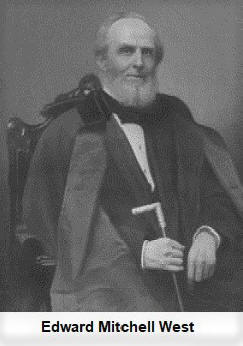 of a county seat.
Substantial improvements began then to be made. The population in
1847 was about seven hundred, and by 1860 had grown to two thousand.
of a county seat.
Substantial improvements began then to be made. The population in
1847 was about seven hundred, and by 1860 had grown to two thousand.
Edward M. West came to Illinois with his father, Tilghman H. West,
when four years old. In 1834, he learned the mercantile business at
Alton with Godfrey, Gilman & Co. In 1858, he went into the banking
business in Edwardsville. Among other men who carried on in the
mercantile business were Alfred J. Lusk, Orren Meeker, Frederick T.
Krafft, William Peel, Edward S. Brown, William Gillham, and Julius
L. Barnsback.
THE LAND OFFICE
The Land Office in Edwardsville was an important institution and
brought many visitors to town. On the first Monday of October, 1820,
the President of the U. S. made a proclamation of public sales of
land in the Edwardsville district, 38 townships, and fractional
townships. The sales of land for two weeks in the following January
amounted to $26,500. Advertisement was made in the newspapers of the
banks whose bills would be received at the land office. In 1820,
these banks were the Bank of the United States, Bank of Illinois at
Shawneetown, Bank of Edwardsville, and more.
EARLY EDWARDSVILLE BANKS
The Bank of Edwardsville
The Bank of Edwardsville was incorporated January 9, 1818. The bank
was chartered to continue until the first day of January 1838. The
management of its affairs was placed in the hands of a board of nine
directors. The cashier in 1819 was Benjamin J. Seward, who was
succeeded by R. T. McKenney. The establishment of the bank had a
favorable influence on the prosperity of Edwardsville, but like all
the other banking enterprises of that time, the institution failed.
The Bank of West & Prickett
This bank was located on Purcell Street, and was established on
January 1, 1868. It had a Hall’s burglar-proof safe, with a time
lock.
Farmers’ Exchange and Loan Company
This bank was chartered on March 21, 1867, but did not opened for
business until October 1869. It was located on Main Street. On April
20, 1881, it assumed the name of J. A. Prickett & Sons. It contained
a Hall’s burglar-proof safe with time lock.
EARLY EDWARDSVILLE HOTELS
Lusk Hotel
The first hotel in Edwardsville was built by John T. Lusk on Main
Street. It was a long, log building, and had three large rooms
fronting the street. After Lusk closed the hotel, the center of
these rooms was used for the post office. One end was rented to Mrs.
Howard who kept a pie and cake shop, and in the other end was a
saloon.
Wiggins Hotel
The Wiggins Hotel stood on the public square, east from the old
jail. It had an extensive and fashionable patronage, and many
distinguished men ate and slept within its walls. Its walls were so
badly cracked by an earthquake, that it was necessary to abandon the
building. It was purchased by Isaac Prickett, who torn the building
down and used the brick to build two small houses on Main Street.
Hopkins Hotel
William H. Hopkins had a hotel in “upper town.” It was a frame
building, which stood opposite the southeast corner of the public
square near the residence of Henry C. Gerke.
Second Lusk Hotel
A second hotel was constructed by John T. Lusk on the property later
occupied by the Wabash Hotel. It was a large frame building, which
was destroyed by fire in 1839. Meriam Patterson kept this hotel for
a time. His successor was Horatio G. Street, and he was followed by
Cassius Hesket. While Mr. Street was proprietor, in about 1830, it
was renowned for the excellence of its fare and the superior manner
in which it was conducted. The fashionable people of St. Louis
patronized it during the summer months, and on Sundays it was a
frequent resort of Alton citizens. During Hesket’s administration,
the old frame building burned down. Another structure was erected in
its place, and was considered a remarkably fine specimen of
architecture.
St. James Hotel
The St. James Hotel was erected in 1873 by Hugh Kirkpatrick, and was
located on Main Street, about one-half square from the courthouse.
Including grounds and furniture, it cost $20,000. It was a fine
brick structure, three stories high, with a basement. It had the
capacity of accommodating 75 guests, and had two sample-rooms, a
commodious office, and a dining room.
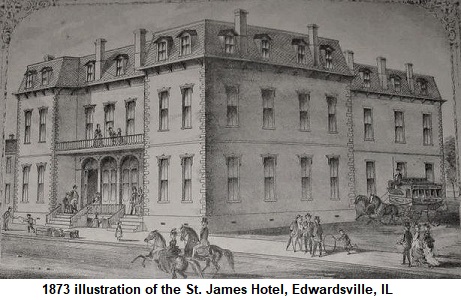
Other Hotels
Other hotels included the Hoffman House, established by A. Hoffman,
was a brick hotel located on Main Street, fronting Courthouse
Square; Bernreuther House, kept by David Bernreuther; the Broadway
House, kept by Henry Daube; the Wabash Hotel, kept by Mrs. Anna
Swarz; the Union House, kept by Fritz Gubritz; and the Railway
House, kept by William Storig, and located at Edwardsville Junction.
FOR MORE ON HOTELS, CLICK HERE.
EARLY SCHOOLS IN EDWARDSVILLE
In the Spectator of 1820, Madame De Jerome announced she had opened
an academy of science in which French, geography, history, drawing,
and arithmetic were taught. She also taught young ladies the art of
embroidery and needle work. The school was open every day during the
week, except Saturday and Sunday, from nine to twelve in the
morning, and two to five in the afternoon.
One of the early teachers in Edwardsville was Joshua Atwater, who
taught a couple of years previous to 1820, when he then opened a
store. Don Alonzo Spaulding, during six months of 1819, taught
school in Edwardsville. The first schools were mostly “loud
schools,” in which all pupils studied their lessons aloud so that
they could be heard at some distance away. Early schools were
usually taught by men, but a Miss Hastings was hired to teach, and
had no trouble in controlling the boys, and maintained an excellent
school. In 1829, John York Sawyer taught school in a frame building,
which stood on Main Street adjoining the jail property. Sawyer
taught until he became the editor of the Spectator. He was succeeded
by Thomas Atwater, a brother to Joshua, and by an Englishman by the
name of Scandrit. Mrs. Stearns subsequently kept a school in the
house which later became the residence of Matthew Gillespie. Between
1830 and 1840, a school taught by John Barber was located three
miles south of town. Barber was a man of superior education and was
an excellent teacher.
The Edwardsville Female Academy was established in May 1831, through
the efforts of James Mason, William P. McKee, Dr. B. F. Edwards,
John Adams, and other leading citizens. The tuition was from $2.50
to $3.50 per quarter. The school was held in a frame building on
Third Street. Miss Alden came from the East to take charge of the
academy, but her connection with the school was severed by her
marriage to the Rev. Mr. Jenney, a Presbyterian minister of Alton.
The next principal was Miss Chapin, who became the wife of the Rev.
Mr. Hale, a Presbyterian clergyman of Springfield. She was succeeded
by Miss Loomis, daughter of a Baptist minister. She married Cyrus
Edwards. The school had a good patronage, but the rapid changes in
the faculty destroyed its usefulness. The building was later used
for a public school, but was later moved to the corner of Third and
Purcell Streets, and was occupied by T. C. Clark as a grocery store.
A Presbyterian minister named Young taught a parochial school for
some years. Samuel Allard taught school several years in the old
academy building. He afterward became a teacher in Shurtleff
College. In 1838, Mr. Gibson, a minister, taught school. He drank
whiskey, ate opium, and preached an occasional volunteer sermon.
Among subsequent teachers were Messrs. Dwight, Potter, and Terry.
Edwardsville contained two public schools in the early days,
including one for African-American students. The question of
building a schoolhouse was suggested in the year 1859. A vote was
taken for and against the proposition of borrowing $9,000 to erect
the building. The vote was in favor of raising the money. A site was
chosen, but the sum voted was too small for its erection. The plan
was submitted to the people, who adopted it and authorized a loan
sufficient to cover the expenses. The schoolhouse constructed was a
brick structure, three stories high, with a basement. Nine teachers
were employed, besides the principal, and it had an early attendance
of between five and six hundred students.
EARLY CHURCHES IN EDWARDSVILLE
The earliest church in Edwardsville was a Presbyterian Church,
formed March 17, 1819, with fifteen members. In a few years the
society became extinct. It was revived by the Presbytery of Alton,
in about 1828. The Rev. James Ewing was pastor from 1845 until his
death in 1848. The congregation used the Baptist Church during this
time. In 1856, the Episcopal Church was leased, with Rev. L. P.
Bates as pastor. He died in 1859.
The Methodist Episcopal Church was organized December 1827. Members
were: Richard Randle, Rev. Washington C. Ballard, Elizabeth Ballard,
Thornhill Ballard, Mary Brooks, Rebecca Atwater, Joel Neff, Sarah
Wright, Josias Randle, Heiress Baker, Marilda Wilder, Samuel A.
Walker, Mary Ballard, Alexander Miller, Aletha Ballard, Agnes H.
Ballard, Elizabeth Gibson, Alworth Baker, Mary Adams, William
Galligher, William P. McKee, Sarah H. McKee, Hail Mason, Grace
Mason, Joshua Atwater, Ann M. Randle, William Miller, Katherine
Miller, Alexander White, Susannah Kendall, Julia Ann Atwater, Sarah
Cotter, Elizabeth Randle, Hosea Armstrong, Samuel McNeal, and Roland
Ballard. In 1830, it was decided to build a house of worship, and
James Mason gave the congregation a lot on which was erected (in
1831) a plain frame building, 40x60ft. In 1854 a brick building
replaced the original.
The Baptist Church was organized at the house of Dr. B. F. Edwards
in 1828. Rev. Mr. Bradley was pastor for some time. The first church
building erected by the congregation was later used as an
engine-house.
St. Mary’s Catholic Church was organized in 1843, and a frame church
erected. Previous to this, Catholic services had been held in
Edwardsville at irregular intervals. The Rev. Mr. Reiss was one of
the early pastors. St. Boniface’s Church, a congregation of Catholic
Germans, was formed in 1867, and a church building erected that
year.
St. Andrew’s Protestant Episcopal Church was organized in 1841. A
commodious frame church building was soon afterward erected, in
which services were held for a number of years.
The German Methodists held religious services in Edwardsville as
early as 1847, and in 1860 the congregation at Edwardsville was made
a separate charge.
INCORPORATION OF EDWARDSVILLE
On Saturday, May 30, 1837, a meeting was held in Edwardsville at the
court house, at which a vote was taken on the question of whether or
not the town should become incorporated, under the general law of
1831. James Wilson was chosen president, and William T. Brown,
clerk. Fifty-seven votes were cast in favor of incorporation, and
seven in the negative. On February 10, 1853, the town was again
incorporated by special act of the Legislature, which provided that
the corporate powers and duties of Edwardsville shall be vested in
five trustees, who shall be elected on the first Monday in April of
each year. This organization existed until October 23, 1872, when it
was organized as a city under general law.
EARLY MANUFACTURING IN EDWARDSVILLE
Kirkpatrick/Mason and Randle Mills
The first manufacturing enterprise in Edwardsville was the old water
mill of Thomas Kirkpatrick. This mill passed into the hands of Paris
Mason, who carried it on for some years until the floods in the
Cahokia caused such damage that its maintenance was no longer
profitable. About the year 1818, Josias Randle, the first County
Clerk of Madison County, constructed an ox mill near his residence,
which was carried on after his death by Josiah Randle, and later by
George D. and John H. Randle. The Randles, along with their
father-in-law, Aaron Arnold, turned this ox mill into a steam mill
about the year 1832. This was the first steam mill in Edwardsville.
The mill was destroyed by fire soon after being placed in operation.
Adams Castor Oil Mill
The castor oil mill of John Adams was carried on successfully for
several years. It was established in 1825. That year he made 500
gallons of oil, which sold at $2.50 a gallon. The next year the
product had increased to 800 gallons, with the price falling to
$1.50. In 1827, 1,000 gallons were made, and sold at $1.25 a gallon;
and in 1828, 1800 gallons, with the price of $1.00 a gallon. In
1829, 500 gallons were made, and in 1830 the production rose to
10,000 gallons. One bushel of castor bean yielded about 7 quarters
and a half pint of oil. Before starting his oil mill, Mr. Adams had
erected a fulling mill on the Cahokia, which was placed in operation
in 1823.
Edwardsville Steam Mill
The Edwardsville Steam Mill Company was organized in 1839. J. C.
Dugger was President of the company. Later the stock came into the
possession of George W. Phillips, who operated it for a number of
years.
Edwardsville Mill and Elevator
This industry was established by the Kehlor Brothers in the spring
of 1879 on Main Street, about three blocks north of the old
courthouse. The mill was a brick building, four stories high with a
basement. The machinery consisted of the latest roller process, 33
pairs of rolls and 3 burrs, with a capacity of manufacturing 600
barrels of flour in twenty-four hours. The product was shipped to
different parts of the U. S. and Europe. The elevator, 60 feet in
height, had the capacity of elevating 10,000 bushels of wheat daily,
and storing 110,000 bushels. A detached warehouse, 100x104 in size,
was capable of storing 7,000 barrels of flour. The engine room was
constructed of brick, using a Harriss-Corliss engine,
300-horsepower.
Oak Hill Refining Company
This factory was located on the on the farm of C. M. Schwarz, about
a half mile from the city limits. Mr. Schwarz grew his own sugar
cane and was manufactured into syrup. In 1880, a partnership was
formed with Belcher, under the name of Belcher & Schwarz. They
manufactured cane into sugar. The season of 1880 was a disastrous
one, and no attempt was made to make sugar, other than in an
experimental way, although 6,000 gallons of syrup were manufactured.
In 1881, the firm organized a stock company under the name of “The
Oak Hill Refining Company of Edwardsville.” The directors were:
George C. W. Belcher, C. F. Miller, Dundas, C. M. Schwarz, B. R.
Burroughs, and F. K. Gillespie. George C. W. Belcher served as
President, B. R. Burroughs, Vice-President, and C. M. Schwarz as
Secretary and Treasurer. As of 1882, the company was still in growth
and struggling.
Springer & Brothers Carriage Manufactory
This carriage factory was located on the north side of Vandalia
Street, one block south of the public square. It was established by
H. J. Springer in the spring of 1870, and occupied a brick building
two stories high, 30x65 feet. A two-story frame building was
attached and was used for a painting and trimming room. The factory
machinery was driven by a four-horsepower steam engine and
manufactured about fifty carriages per year. Connected with the same
building was the firm of Gillespie & Springer, engaged in the
manufacture of patent thill couplings.
Gessert’s Custom Flour Mill
This business was established by George Gessert in the fall of 1877,
and commenced operating the following January. The mill was a frame
building, located on Second Street near Union Street, two stories
high. It contained two run of burrs, and had a capacity of grinding
thirty-five barrels of flour daily. The machinery was driven by a
thirty-horsepower engine.
Desmond Carriage, Wagon and Machine Shop
This business was located on the corner of Vandalia and St. Louis
Streets. It was built in the spring of 1874 by Michael Desmond. The
building was a frame, two-story building, where they repaired
machinery and general work. Another building connected with the stop
for the purpose of doing the woodwork was 40x30 feet.
Dippold Cooper Shop
This business was owned by Martin Dippold, and was located on the
southwest side of the railroad, on St. Louis Street, near the
Wabash, St. Louis, & Peoria Depot. There was a branch shop located
in lower town. This business furnished Edwardsville flour mills with
barrels to ship their flour. Thirty-eight men were employed, and
80,000 barrels were manufactured annually.
Weber & Son Wagon and Carriage Manufactory
This business was established in the spring of 1873, and was located
on Vandalia Street, two blocks southeast of the courthouse. The
elder of the firm had been engaged in the business in Edwardsville
since 1854. The building was a frame, 50x80 feet, two stories high.
A one-story frame attachment was used for storing woodwork, lumber,
etc.
Star Flour Mill
The Star Flour Mill was founded by Jacob Dunstedter. It was erected
in the summer of 1866 at a cost of $15,000, on Second Street, near
the railroad. It was a frame building, three stories high with a
basement, with 54 feet frontage, and was constructed in the shape of
an L. It had four run of stone, with a capacity of making 125
barrels in twenty-four hours. This was purely a merchant mill, and
shipped its flour both to the East and West.
Starmer's Madison County Marble Works
The marble works was established by G. J. Starmer in the spring of
1880, and was located on Main Street, opposite the courthouse. The
building was a small frame, one story, with a workshop in the rear
of the salesroom.
Enterprise Marble Works
This business was located at the corner of St. Louis and Vandalia
Streets, and was established by Edward F. Koch.
Begemann Cigar Manufactory
This business was established by F. Begemann in 1867, and was
located on Main Street, east of the square. It manufactured 250,000
cigars annually. All goods were handmade and sold at various points
in the state.
Harles Soda Factory
This soda factory was established by Frank Harles in the spring of
1871, and was located on Main Street, one block south of the
courthouse square. The factory manufactured three to four thousand
boxes of soda-water per annum. Mr. Harles also supplied the city
with ice.
Wolf Brothers’ Coal Mine
This mine was located about one-half mile southeast of Courthouse
Square. It was sunk by the firm in the summer of 1879, with a
capital investment of $20,000. Its depth was 217 feet to the surface
of some of the finest quality coal found in this part of the state.
Seven thousand bushels of coal were raised daily, when running at
full capacity, and required 150 men to operate it.
St. Louis and Edwardsville Coal Company
This mine was located on section 10, on the city branch of the
Wabash, St. Louis, and Pacific Railroad. The shaft was sunk by
Tunstell & Holmes in 1868 or 1869. About ten years later, it was
purchased by John A. Prickett, and leased by the above company in
the fall of 1881 for 20 years. The depth of the shaft was 125 feet.
When fully worked, it mined 2,800 bushels of coal daily.
Schramek Coal Mine
This mine was opened by Frank Schramek in the spring of 1879, and
was located on the Wabash, St. Louis, and Pacific Railway on Union
Street. Its depth was 65 feet. In the busy season, twenty-five men
were employed, mining 200,000 bushels of coal within the year. The
main shipment of coal was to St. Louis.
Ritter - Smidt Coal Mine
This mine, owned by Mrs. Smidt, was located near the Wabash, St.
Louis and Pacific Depot. It was opened by Henry Ritter about 1857,
and came into the possession of Mrs. Smidt in 1877. The depth of the
mine was 96 feet, with five to six hundred bushels of coal produced
per day.
Hellrung’s Brick Yard
This industry, established about 1850 by D. Brown, passed into the
hands of Louis Klinger in 1860, and was purchased by Hellrungs in
1867. It was located about a quarter of a mile northeast from the
public square. It had but one kiln, and annually turned out about
170,000 bricks.
R. B. Evans & Co. Elevator
This elevator was located on the south side of the railroad track,
above the Wabash depot. In was built in the fall of 1876, and was a
frame building, 20x40 feet, with a machine room attached. It had the
capacity of elevating 5,000 bushels of corn per day.
Naeher Machine Shop
This business was established by Edward Naeher in 1871. In 1873, a
foundry was run in connection with the shop, but was found to be
unprofitable and was abandoned. In 1878, a sawmill was attached, but
it was moved to the country a short time later. The building was
located on Second Street, a little south and east of the Star
Flouring Mill. The business conducted in general repair work.
Sherman Elevator
This elevator was established by M. B. Sherman, and was located on
the Edwardsville Mill Switch, southwest of the big flour mill. It
was build in the spring of 1875, and had a capacity of shelling and
elevating 2,500 bushels of corn daily.
Bardelmeier Brick Yard
This company was established in 1876 by William Bardelmeier, and was
located in Wheeler’s Addition, about one-fourth mile east of
Courthouse Square. Two kilns were kept in operation, which
manufactured about 300,000 bricks yearly.
Hettergott Brick Yard
In the same local as the Bardelmeier Brick Yard was the Jacob
Hettergott Brick Yard. This business had one kiln, and went into
operation in the spring of 1881.
Crocker’s Vegetable Gardens
This company was established by C. W. Crocker in the spring of 1864
and was located in Upper Edwardsville. The property consisted of
eight acres, with four hot-houses. All kinds of plants and
vegetables were cultivated, shipping to Chicago, St. Louis, Decatur,
Litchfield, and other towns.
FIRE DEPARTMENT
Fire Company No. 1 was organized February 7, 1874, and consisted of
hose,
hook and ladder, and engine departments. The first officers of
the hose company were Fred Sochlke, Captain, and Joseph Hentz,
Assistant. The hook and ladder company included officers Arnold
Schultz, Captain, and Albert V. D. Broeck, Assistant. All members
belonged to the engine department, with William Friday as First
Chief and Charles Silze, Assistant. This fire company was well
uniformed and performed their duty well.
PUBLIC LIBRARY
In 1819, some of the men of Edwardsville established one of the
earliest lending libraries in the new State of Illinois. By 1825,
this library had vanished. A new Edwardsville Library Association
was created by a group of women in May of 1879. The library was open
one day a week. An early home in the Episcopal Church found the
books neatly arranged on the front pews. Eventually in 1894, the
library was granted a room in the new City Hall. Townswomen raised
money for books from 1879 to 1903, by raffling quilts, giving card
parties, and putting on operettas. This library was open to those
who paid a $2 annual fee, until it became a free public library in
1903. In that year, Andrew Carnegie, millionaire founder of U.S.
Steel, donated $12,500 for a new building. As part of the agreement,
the city agreed to budget $1,250 per year for library expenses. The
new library, located at 112 S. Kansas Street, was dedicated on June
28, 1906. The building was remodeled in 1990.
NEWSPAPERS
Following statehood in May 1818, Hooper Warren began to publish
Edwardsville's first newspaper, The Spectator, which lasted until
1826.
The Star of the West was published by Miller and Stine beginning
September 14, 1822. It was the fourth newspaper published in
Illinois. The name of the newspaper changed to the Illinois
Republican in April 1823, and ran until July 1824. Judge Theophilus
W. Smith and Emanuel J. West were the leading editors, who
endeavored to counteract the influence of the Spectator.
The Illinois Corrector was published from 1827 – 1828. It was a
four-column Democratic paper, edited by R. K. Fleming. It was a
pro-slavery newspaper.
*********
HISTORY OF LECLAIRE
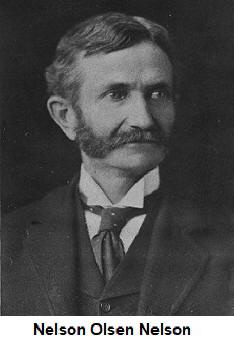
The industrial portion of the town, which in 1912 numbered about 650
people, had about fifteen one-story buildings which were modern,
surrounded by beautiful lawns and flower beds. Nelson’s industrial
shops included brass work, nickel and silver fittings, plumbers’
woodwork, planing mill, and architectural marble and machinery.
Nelson stressed the importance of education, and founded the
Leclaire school for employees and their children. He believed that
“the hand, the heart, and head must be education together.”
The residential portion of Leclaire was beautiful throughout. It had
a hedge, thirty feet high, to separate homes from the factories.
There was a large common, covered with grass for outdoor sports such
as baseball and football, and there was a large assembly hall for
lectures, dances, and indoor entertainment. This was also used as a
schoolhouse. A special playground was well equipped for the
children. All of this was free to use by residents of Leclaire, with
the only stipulation made was that no admission fee or charge of any
kind was made. Leclaire had the same water, telephone, and mail
service as Edwardsville, but a separate electric system and fire
department.
Nelson died in October 1922, at the age of 78. He is buried in the
Bellefontaine Cemetery in St. Louis, Missouri. Leclaire was annexed
into the city of Edwardsville in 1934.
Nelson’s business was sold to Wagner Electric Corporation in the
late 1940s, which eventually closed in 1957. The site remained
vacant until the Southern Illinois University Foundation purchased
the property in 1964, and then sold the facilities to the university
in 1972. The campus was used by the university for classes, offices,
and storage for nearly 20 years. The property was then deeded to
Lewis and Clark Community College in 1999.
Today, the Leclaire National Historic District encompasses a
23-block area, with approximately 415 single-family homes, which
were built in the styles of Queen Anne, Craftsman, Colonial Revival,
and Bungalow.
Leclaire Park is one of Edwardsville’s oldest and most beautiful
parks, consisting of a little over 5 acres. The lake in the park
served a dual purpose of providing water for Nelson’s factories and
was a recreational lake for residents and visitors. A pavilion was
constructed for band concerts, and a boat house held skiffs built in
the Leclaire factories. The lake was stocked, and many fished from
its shores or from skiffs. In the winter, ice skating was enjoyed on
the Leclaire lake. In the late 1940s, it was determined the water
was not clean enough for swimming, and the city banned swimming.
